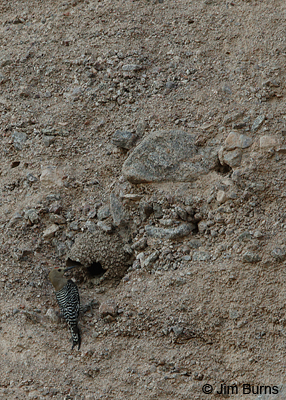
The first 100 degree day of 2017 found me out with the camera along the Salt River. I had gone out early, more to change my normal routine than to beat the heat, but I was quickly reminded how much triple desert digits also change the routines of those who must survive in them. Birds are active before sunrise. Predators are out at first light.
Within the first twenty minutes, before shadows even hit the river, I had seen Coyote, Bald Eagle, Peregrine Falcon, American Kestrel, Gila Woodpecker . . . wait! What? Yes, that’s a list of the predators I had seen before sunrise. Keep reading.
Many years ago in south Texas I had watched in dismay as a Ferruginous Pygmy-Owl hung upside down below the opening on the mud nest of a Cave Swallow and snatched a nestling for breakfast. I shouldn’t have been surprised. Pygmy-Owls are avian predators known to be opportunistic. That same pair had been seen sitting on the transom of an old hay barn waiting for the bats to emerge at sundown.
We know Coyotes will take bunnies and feral cats, and they will rob the nests of ground dwelling birds. Gambel’s Quail eggs must be a Coyote delicacy. Bald Eagles take fish out of the Salt of course, but I’ve seen them take coots and was told of one chasing a Great Blue Heron. Peregrines along the Salt stoop on swifts and swallows among other prey species, and I’ve seen a large cloud of Cliff Swallows noisily escorting a kestrel away from their cliff face colony of nests, obviously recognizing its predatory potential.
So, how and why would Gila Woodpecker make this list of predators? We usually see Gilas in two scenarios--exploring crevices and cavities in the bark along the trunks of desert Mesquites and gleaning insects and pollen atop Saguaros. They take ants, beetles, spiders, grasshoppers, and moths in addition to feeding on Saguaro fruit and Mistletoe berries. But “omnivorous” and “opportunism” begin with the same letter.
The sun was just hitting the peaks, but the river and the cliff face were still in shadow when I noticed a bird larger than the swallows approach and stick to the rock wall. The swallows swoop upward to their nests, linger as they deliver food, then fall away. This larger bird flew in perpendicularly and clung to the vertical face, probed, peered around, moved several feet, probed again—a completely different jizz than that of the ubiquitous swallows. A quick binocular look confirmed woodpecker—Gila male.
I watched as the woodpecker, acting like nothing so much as a Canyon Wren, explored grottoes and poked into cracks in the rock, presumably extracting spiders, working its way up and across the wall, the swallows paying it no mind. And then it did something that blew me away. It flew to the entrance of a swallow nest, hesitated, then grabbed a downy nestling, and flew off. Who knew!? Neither I nor the swallows.